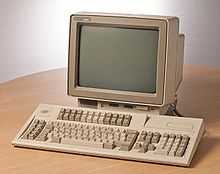IBM 5250

IBM 5250 was a family of block-oriented terminals originally introduced with the IBM System/34 midrange computer systems in 1977.[2] It also connected to the later System/36, System/38, AS/400, System i, and IBM i Running on Power systems.
Components
5250 devices could be directly attached to the host or communicate remotely using Synchronous Data Link Control (SDLC) at up to 9600bit/s. Devices could also be clustered or daisy-chained.
In 1978 the 5250 system consisted of the following components:[3]
- 5251 Display Station. The monochrome text-only display could be either 960 characters, formatted as 12 lines of 80 characters, or 1920 characters as 24 lines of 80 characters. Upper and lower case was standard. Text attributes consisted of blink, high intensity, reverse video, nondisplay, underscore, and a unique column separator that caused the field to be preceded and followed by a vertical bar. 5251 and 5252 input format control attributes were optimized for data entry applications and offered significant enhancements over previous 3270 terminals.
- 5252 Dual Display Station. The 5252 featured dual CRTs back to back in a single case, with separate keyboards. The 5252 was not part of the initial announcement.
- 5256 printer. The 5256 was a tabletop serial dot matrix printer with three models providing speeds of 40, 60, or 120cps and a print line of 132 characters.
5251/5252 format control
Field attributes also defined the type of data the operator could enter into a field, and specified other control information for the field.
- A field could be defined as alpha only, numeric only, or alphanumeric.
- Auto enter simulated an ENTER key press at the conclusion of the field.
- Bypass automatically skips over a field in the screen.
- Duplicate enable allows the operator to press the DUP key in a field, entering a special code which was interpreted by the application program – typically duplicating data in this field from the previous record or line.
- Field exit required forced the operator to manually exit this field, rather than automatically advancing to the next field after entering the last character.
- Mandatory entry specifies that the operator must enter data in this field and is not allowed to tab over it.
- Monocase translates lower-case characters entered into this field to upper-case.
- Mandatory fill specifies that this field must be entirely filled if any data is entered into it.
- Right adjust will right adjust data entered in a field when the operator exits the field.
- Signed numeric reserved the rightmost position of a field for a sign – blank for positive or '-' for negative.
Historical origins
The 5250 is a block-oriented terminal similar to the IBM 3270 but is not compatible with the 3270. Robustly constructed, 5251 terminals weighed roughly 36 kilograms (79 lb). The devices generated an audible clicking sound as the user typed, similar to the electric typewriters of the era.
The 5250 data stream definition has been refined over time to include GUI elements such as pop-up windowing, check and option boxes, mouse handling, and pull-down menus. The term "5250" now refers to the data stream itself. Few physical 5250 terminals with their bulky twinax cables still exist, although they are still used to provide a "connection of last resort," hard-wired to the host computer. Today, it is more common to use PC or web-based terminal emulation packages that can interpret and display 5250 data streams.
Telnet 5250
Telnet 5250, or TN5250 describes either the process of sending and receiving 5250 data streams using the Telnet protocol or the software that emulates a 5250 class terminal communication via that process. TN5250 allows a 5250 terminal emulator to communicate over a TCP/IP network instead of an SNA network. Standard telnet clients cannot be used as a substitute for TN5250 clients, as they use a different data stream format.
See also
- IBM System i
- Terminal emulator
- 3470 with 27 lines by 132 characters/line
References
- ↑ An IBM System/34
- ↑ IBM Corporation. "What was the IBM System/34?". Reference / FAQ / Products and Services. Retrieved December 4, 2012.
- ↑ IBM Corporation (1978). IBM 5250 Information Display System: IBM 5251 Display Station IBM 5252 Dual Display Station IBM 5256 Printer Introduction.
External links
- "FTP software repository at IBM"
- RFC1205 – 5250 Telnet interface
- RFC2877 – 5250 Telnet Enhancements
- RFC4777 – IBM's iSeries Telnet Enhancements